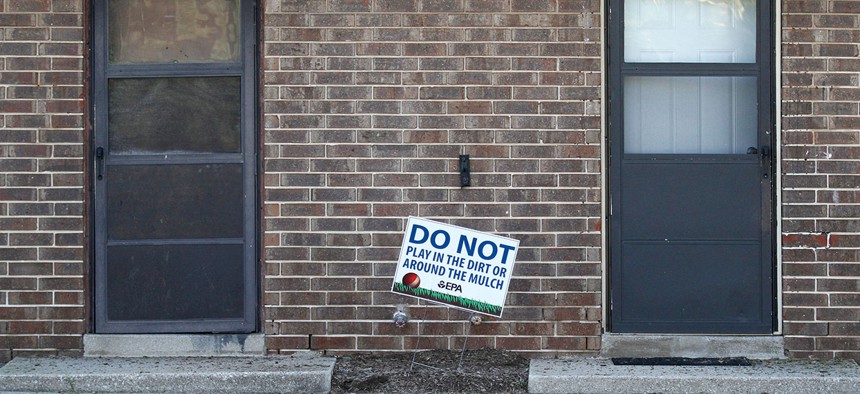
In this Aug. 23, 2016 photo, a sign from the Environmental Protection Agency is posted in front of West Calumet Housing Complex houses at East Chicago, Ind. Tae-Gyun Kim/AP
Is the EPA Doing All It Can to Protect Children From Lead Poisoning?
A lawsuit filed by a group of environmental organizations tracking lead’s effects says no.
Ever since the Flint lead crisis captured national attention last year, there has been tremendous pressure on the U.S. Environmental Protection Agency to upgrade its regulation of toxic lead exposure. It’s a problem that the agency perhaps thought was under control after it ordered a ban on all lead-based paint for homes decades ago.
That’s simply not been the case, however, says a lawsuit filed on August 24 by a coalition of environmental organizations against the EPA over its lead regulations. The lawsuit claims that the EPA hasn’t updated its lead-dust hazard standards, nor modified the definition of lead-based paint to bring it in line with the latest science around public health risks, as the agency pledged to in 2009. When environmental organizations brought their lead concerns to the EPA that year, the agency responded that this would be made a priority, but that it wouldn’t set a specific deadline for finalizing new rules. The groups behind the lawsuit now say the EPA hasn’t made any progress at all.
The seven-year delay on this is not only “unreasonable,” but “egregious,” reads the lawsuit. The coalition behind it includes organizations such as the Sierra Club, Earthjustice, California Communities Against Toxics, New Jersey Citizen Action, the New York City Coalition to End Lead Poisoning, and WE ACT for Environmental Justice. They’re asking a federal court to require the EPA to finally propose new lead-hazard standards within 90 days, and to finalize them within six months.
“The most common cause of lead poisoning in children in this country is the ingestion of lead dust from old house paint,” said Earthjustice attorney Hannah Chang, who filed the suit on behalf of the coalition, in a press statement.
The dangers of lead ingestion, which can lead to learning disabilities and neurological problems in children and hypertension and cardiovascular disease in adults, have figured prominently in recent national discussions around protecting black lives. Freddie Gray and Korryn Gaines, two African Americans from Baltimore killed by police, both had health problems related to early lead exposure. This has led to public conversations about the links between environmental violence and police violence when it comes to African Americans. The Flint water crisis has amplified that discussion even further, as has a current scandal involving lead contamination at a public housing complexin East Chicago, Indiana.
One of the children of a mother named in the lawsuit was diagnosed with lead poisoning when he was 3 years old, and today suffers from speech impairments. The lead problem particularly affects cities with dense housing stock, built mostly before 1950. In Los Angeles County, 99 percent of the lead poisoning cases there are connected to old housing or contaminated soil surrounding that housing, according to the suit. Dr. Adrienne L. Hollis, the federal policy director for WE ACT for Environmental Justice, notes in the suit that more than 80 percent of new cases of lead poisoning in New York City* are in black, Latino, and Asian children.
From the lawsuit:
To date, EPA, after acknowledging the need to re-evaluate the current standards, has made either no progress in the case of modifying the definition of “lead-based paint” or taken only stalled steps towards actually revising the standards in the case of the dust-lead hazard standards. EPA’s failure to timely proceed with and conclude rulemaking prevents Petitioners from providing comment and input on a proposed rule and ultimately litigating a final rule that may be insufficiently protective. Instead, the agency’s continued stalling leaves Petitioners indefinitely waiting for the conclusion of the promised regulatory actions while, in the meantime, children across the country continue to suffer the irreversible repercussions of exposure to lead in their own homes and daycares.
“EPA’s outdated standards and lack of enforcement let lead remain hidden and silent,” said Queen Zakia Rafiqa Shabazz, the founder of United Parents Against Lead, whose son has lead poisoning, in a press statement. ”We as parents want to protect our children, but we can do little against an invisible enemy. A child is a terrible thing to waste.”






